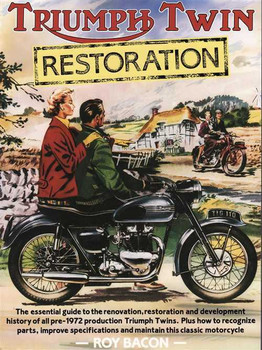Description
Author: Roy Bacon, Softbound,301 Pages, This Edition Publisged by Andover Norton in 2011 (Original 1st Edition by Osprey in 1988)
ISBN: 9780957066526 - Gold Star and all post-war pre-unit B, M and C series, plus unit four-strokes and Bantams
This book began as others in the Osprey restoration series, but it was soon realized that the vast range of models and all the data on BSA singles would far outstrip the space available. Because of this it was not practical to publish it in the same style as the others, and if we had, the sheer bulk would have been a major handful to use in lounge or workshop.
To cope with this, the book has been revised as a parts information guide complete with all the machine data usually included. What have had to go are the sections on techniques, which are general matters common to all the books.
That information is still to be found in the other restoration books, so if guidance is needed a visit to the local library should give you the answer. It could be best to ask for BSA Twin Restoration, but the Norton or Triumph titles should be equally helpful.
In addition to this source, Osprey are producing a series of books on motorcycle restoration techniques which will cover all the main areas involved. These go into greater depth as they are designed to do just this and show the why and how along with some of the wrinkles that make the job easier.
This has allowed all the data unique to the BSA singles to be gathered together rather than the more general information. The data relates to production models built from 1945 to 1973 and to standard UK specification. It does not cover, but should help with, the late pre-war models or the export ones which differ from the home-specification models for which data is included where known.
In all cases, and regardless of the final aim, it is hoped that this book will assist and guide the reader to produce the machine of his or her dreams. It is also hoped that the-result will be sound in wind and limb and every endeavour has been made to offer advice which is helpful and safe. However, .the onus is always on the reader to ensure that any machine he or she works on or rides is in a safe and legal condition. If you decide to carry out a modification, you must make certain that it will work properly.
Neither the author nor the publisher can accept any liability for anything contained in this book which
may result in any loss, damage or injury, and the book is only available for purchase or loan on that basis.
Machine year
Chapter 1 gives details of the way in which models arc dated, which causes, for example, 1'953 models to run from late 1952 to late 1953. Because of this, the text will use the model year without constant repetition that the feature or model was introduced late in the previous calendar year.
Engine and frame numbers take precedence over model year in determining when a change took place and have been noted where necessary. Parts lists, coupled with these numbers, are always the correct way back to original specification.
Your skills
This book is not a workshop manual, nor is it a primer on being a motorcycle mechanic. It has to assume that you know how your machine works and have a good idea as to how to maintain it. Also that you have a degree of mechanical aptitude and have worked on motorcycles to some extent.
Specifications
There are no extensive tables of data in this book, as much of it is in BSA Gold Star & Other Singles (Osprey Publishing) and the rest in workshop manuals. Collect as much data and information as possible to cover your model and year before starting, but remember that part of the art of restoration is knowing which items matter. Most books don't tell you. So there are no endless lists of gaps, settings or tolerances, while the figures and data that are provided are there to back up the manual.
Note
To avoid constant detailing, the singles will be referred to as pre-unit, unit or Bantam. The first is any of the C, B and M ranges, including the Gold Star series. The unit models are those built from 1959 onwards, starting with the C15, and the Bantams run from the DI to the D175 of 1971.















